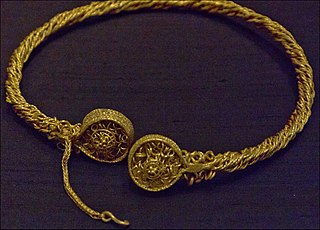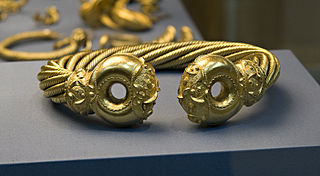
A torc, also spelled torq or torque, is a large rigid or stiff neck ring in metal, made either as a single piece or from strands twisted together. The great majority are open at the front, although some have hook and ring closures and a few have mortice and tenon locking catches to close them. Many seem designed for near-permanent wear and would have been difficult to remove.

Sedgeford is a village and civil parish in the English county of Norfolk, about 5 miles south of the North Sea and 3 miles (4.8 km) east of the Wash. It is 36 miles northwest of Norwich.

The Snape Anglo-Saxon Cemetery is a place of burial dated to the 6th century AD located on Snape Common, near to the town of Aldeburgh in Suffolk, Eastern England. Dating to the early part of the Anglo-Saxon Era of English history, it contains a variety of different forms of burial, with inhumation and cremation burials being found in roughly equal proportions. The site is also known for the inclusion of a high status ship burial. A number of these burials were included within burial mounds.

The Snettisham Hoard or Snettisham Treasure is a series of discoveries of Iron Age precious metal, found in the Snettisham area of the English county of Norfolk between 1948 and 1973.
Spong Hill is an Anglo-Saxon cemetery site located south of North Elmham in Norfolk, England. It is the largest known Early Anglo-Saxon cremation site. The site consists of a large cremation cemetery and a smaller, 6th-century burial cemetery of 57 inhumations. Several of the inhumation graves were covered by small barrows and others were marked by the use of coffins.

Wasperton is a village and civil parish in the English county of Warwickshire. The population of the civil parish at the 2011 census was 153. It is on the east bank of the River Avon and is some 5 miles (8 km) south of the town of Warwick which is easily accessed by the A429 road. Between 1980 and 1985 extensive excavations in advance of gravel digging revealed a cemetery which contained both Roman and Anglo-Saxon graves. There were over 200 inhumations and 26 cremation burials uncovered. 116 inhumations and 24 cremations were determined to be Anglo-Saxon. 40 inhumations have been determined to be Roman, 44 inhumations could not be dated. The graves included spears, shields, knives, brooches and beads.

Neil Faulkner was a British archaeologist, historian, writer, lecturer, broadcaster, and political activist.

The Staffordshire Hoard is the largest hoard of Anglo-Saxon gold and silver metalwork yet found. It consists of almost 4,600 items and metal fragments, amounting to a total of 5.1 kg (11 lb) of gold, 1.4 kg (3 lb) of silver and some 3,500 pieces of garnet cloisonné jewellery. It is described by the historian Cat Jarman as "possibly the finest collection of early medieval artefacts ever discovered".

The Stirling torcs make up a hoard of four gold Iron Age torcs, a type of necklace, all of which date to between 300 and 100 BC and which were buried deliberately at some point in antiquity. They were found by a metal detectorist in a field near Blair Drummond, Perthshire, Scotland on 28 September 2009. The hoard has been described as the most significant discovery of Iron Age metalwork in Scotland and is said to be of international significance. The torcs were valued at £462,000, and after a public appeal were acquired for the National Museums of Scotland in March 2011.

The Sedgeford Torc is a broken Iron Age gold torc found near the village of Sedgeford in Norfolk. The main part of the torc was found during harrowing of a field in 1965, and the missing terminal was found by Dr. Steve Hammond during fieldwork by the Sedgeford Historical and Archaeological Research Project in 2004. The torc is now displayed at the British Museum.
The archaeology of Anglo-Saxon England is the study of the archaeology of England from the 5th century AD to the 11th century, when it was ruled by Germanic tribes known collectively as the Anglo-Saxons.

There are two notable Ipswich Hoards. The first was a hoard of Anglo-Saxon coins discovered in 1863. The second was a hoard of six Iron Age gold torcs that was discovered in 1968 and 1969. The latter hoard has been described as second only to the Snettisham Hoard in importance as a hoard from the Iron Age, and is held at the British Museum.
Burial in Anglo-Saxon England refers to the grave and burial customs followed by the Anglo-Saxons between the mid 5th and 11th centuries CE in Early Mediaeval England. The variation of the practice performed by the Anglo-Saxon peoples during this period, included the use of both cremation and inhumation. There is a commonality in the burial places between the rich and poor – their resting places sit alongside one another in shared cemeteries. Both of these forms of burial were typically accompanied by grave goods, which included food, jewelry, and weaponry. The actual burials themselves, whether of cremated or inhumed remains, were placed in a variety of sites, including in cemeteries, burial mounds or, more rarely, in ship burials.
Polhill Anglo-Saxon cemetery is a place of burial that was used in the seventh and eighth centuries CE. It is located close to the hamlet of Polhill, near Sevenoaks in Kent, South-East England. Belonging to the Middle Anglo-Saxon period, it was part of the much wider tradition of burial in Early Anglo-Saxon England.
Buckland Anglo-Saxon cemetery was a place of burial. It is located on Long Hill in the town of Dover in Kent, South East England. Belonging to the Anglo-Saxon period, it was part of the much wider tradition of burial in Early Anglo-Saxon England.

The Great Torc from Snettisham or Snettisham Great Torc is a large Iron Age torc or neck ring in electrum, from the 1st century BC. It is one of the finest pieces of early Celtic art in a distinctly British Celtic style. It is the most spectacular object in the Snettisham Hoard of torcs and other metalwork found in 1950 near the village of Snettisham in Norfolk, East Anglia. The perfectly intact torc is noted for its high level of craftsmanship and artistry. Soon after its discovery it was acquired by the British Museum.
This page lists major archaeological events of 2016.
Ian David Meadows is a British archaeologist. He has worked in archaeology for some 40 years, including as a Senior Project Officer at Northamptonshire Archaeology from 1992 to 2014. During that time he excavated a number of large quarries in England and Wales, and excavated the boar-crested Anglo-Saxon Pioneer Helmet in addition to discovering the first definitive evidence for viticulture in Roman Britain. He has also worked for the Museum of London Archaeology, and has taught archaeology and landscape history for Cambridge University, Anglia Ruskin University, the University of Bath, and the Workers' Educational Association.
Naomi Payne is an archaeologist and small finds specialist, with a particular interest in Roman material culture. She was awarded her PhD at the University of Bristol in 2003 with a thesis titled: "The medieval residences of the Bishops of Bath and Wells, and Salisbury". She is a research associate at the University of Exeter and was elected as a Fellow of the Society of Antiquaries of London on 25 March 2021.












